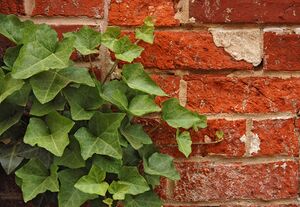| Hedera helix | ||||||||||||||
|---|---|---|---|---|---|---|---|---|---|---|---|---|---|---|
 | ||||||||||||||
| Plant Info | ||||||||||||||
|
| ||||||||||||||
| Scientific classification | ||||||||||||||
| ||||||||||||||
| Binomial name | ||||||||||||||
| Hedera helix L. | ||||||||||||||
Hedera helix (species name from Ancient Greek "twist, turn"), also called Ivy, Common Ivy, or English Ivy is a species of ivy native to most of Europe and southwest Asia. It is an evergreen climbing plant, growing to 20-30 m high where suitable surfaces (trees, cliffs, walls) are available, and also growing as ground cover where there are no vertical surfaces. It holds on to tree bark and rock by means of short adhesive rootlets. The helix part of the name refers to where there are spirals in the leaves.
The leaves are alternate, 4-8 cm long, with a 3-10 cm long petiole; they are of two types, with palmately five-lobed juvenile leaves on creeping and climbing stems, and unlobed cordate adult leaves on fertile flowering stems exposed to full sun, usually high in the crowns of trees or the top of rock faces. The flowers are produced from late summer until late autumn, individually small, in 3-5 cm diameter umbels, greenish-yellow, and very rich in nectar, an important late food source for bees and other insects; the fruit are small black berries ripening in late winter, and are an important food for many birds, though poisonous to humans. The seeds are dispersed by birds eating the fruit.
Plants in southeast Europe and southwest Asia (Greece, Turkey) are treated as a distinct subspecies Hedera helix subsp. poetarum, differing in orange ripe fruit.
The closely related species Hedera canariensis and Hedera hibernica are often treated as varieties or subspecies of H. helix (Flora Europaea), though they differ in chromosome number so do not hybridise readily (McAllister 1982). H. helix can be best distinguished by its usually smaller and slightly more deeply lobed leaves and somewhat less vigorous growth, though identification is often not easy.
Cultivation and uses
It is widely cultivated as an ornamental plant, with numerous cultivars selected for such traits as yellow, variegated or deeply lobed leaves, purple stems, and slow, dwarfed growth.
In North America (where it is often known as English Ivy), it has become naturalised and is sometimes considered an invasive species, especially in the Pacific Northwest where the climate is similar to that in its native area.
Ethnomedical Uses
- Leaves and berries are taken orally as an expectorant to treat cough and bronchitisTemplate:Fact. In 1597, the British herbalist John Gerard recommended water infused with ivy leaves as a wash for sore or watering eyes.[1]
References and external links
- Huxley, A., ed. (1992). New RHS Dictionary of Gardening. Macmillan.
- McAllister, H. (1982). New work on ivies. Int. Dendrol. Soc. Yearbook 1981: 106-109.
- Flora Europaea: Hedera helix
- Ecoflora: Hedera helix
- USDA Plants Profile: Hedera helix
- Plant Encyclopedia: Hedera helix (Photos)


